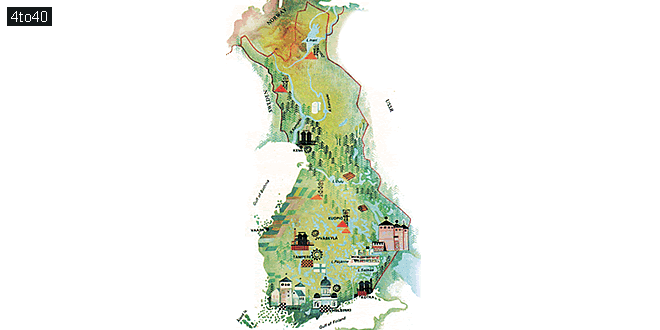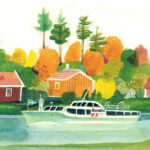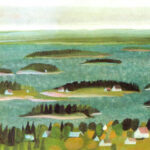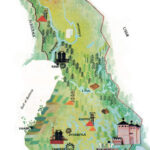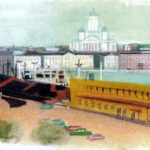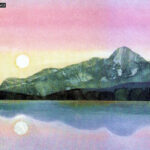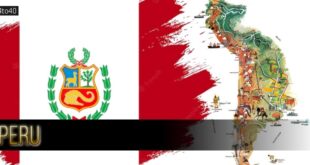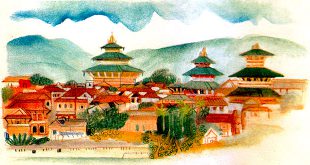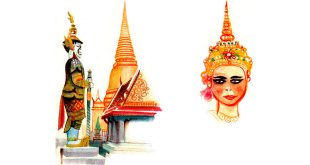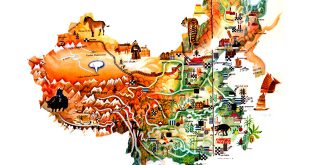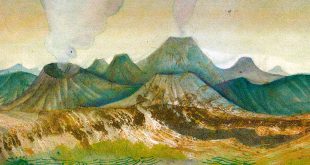Country Name: Finland
System of government: Republic
Capital: Helsinki
Location: On the Baltic Sea between the Gulf of Bothnia and the Gulf of Finland, with the land borders with Sweden and Norway. Finnish territory includes the Alans Islands (Ahvenanmaa) at the entrance to the Gulf of Bothnia. About one-quarter of Finland lies north of the Arctic Circle
Area: 337,032 sq km
National composition: Finns (93%), Swedes (6.5%), some Lapps and Russians
Religion: Protestant (Lutheran National Church)
Official languages: Finnish (Suomi), Swedish
Currency: Euro
Administrative divisions: Finland is divided into 19 regions
Other major cities: Tampere, Turku, Espoo
Highest elevation: 1,324 m in the Scandinavian Mountains
Chief rivers: Kemijoki, Tornio
Largest lakes: Saimaa, Paijanne, Nasijarvi, Oulujarvi, Haukivesi, Kallavesi
Climate: Continental, moderated by maritime influences; sub-arctic in the north
Finland represents a transition region between the Scandinavian Mountains (or the Baltic Shield) and the Russian Plain. Its scenery was largely determined during the Pleistocene Ice Age. The southeastern part of Finland includes the lake district, which is dotted with thousands of lakes that fill ice-worn basins or morainedammed hollows. Some lakes are interconnected by waterways and so form a transport network. In places the lake district resembles an inland sea containing numerous islands. The largest rivers occur outside the lake district, in the north. They are characterized by large volumes and steep gradients. Most rivers freeze over in winter.
Finland Encyclopedia & Facts For Students
Finland is Europe’s most forested country, and woodland covers more than 70 per cent of the total area. The forests are extremely rich in animal life, including the elk, fox, hare, lynx and wolf, as well as many bird species. The lakes abound in such fish as perch, pike, salmon and trout.
The country’s chief natural asset is its forests and much of Finland’s industrial sector is geared to process timber, producing much pulp, paper and other wood products. Agriculture, forestry and fishing employed 11 per cent of the workforce in 1980. Cultivated land covers 9 percent of Finland and most farms are in the south. Barley, hay, oats, potatoes and wheat are the leading crops and the production of sugar beets is increasing. Dairy farming and the rearing of pigs and poultry are important. The Lapps in the north breed reindeer, and fur farming, especially mink and blue fox, is a significant activity.
Finland Map:
Finland’s other resources includes asbestos, cobalt, copper, iron ore, nickel, uranium and vanadium. Kaolin, graphite, granite, limestone and other building materials are quarried in large quantities. Finland is one of Europe’s leading smelters of copper and nickel. Finnish shipyards specialize in building icebreakers and they also produce liners, merchant vessels and tankers.
The engineering industries manufacture paper making and woodworking machinery, agricultural machines and earth-moving equipment. The chemical industry exports fertilizers, paints, varnishes and dyestuffs, plastics, cosmetics and pharmaceuticals. The comparatively recent diversification of Finnish industry has increased the country’s prosperity. In 1981 Finland had the high per capita gross national product of US $10,680, which is high per capita gross national product of US $10,680, which is higher than that of the United Kingdom.
Finland National Anthem:
Maamme - Finland National Anthem
“Maamme” (“Our Land”) is the de facto national anthem of Finland. The music was composed by the German immigrant Fredrik Pacius, with original Swedish lyrics by Johan Ludvig Runeberg. It was first performed with the current melody and lyrics on 13 May 1848. Originally, it was written for the 500th anniversary of Porvoo, and for that occasion it was Runeberg himself who wrote the music.
The melody of “Maamme” is also used for the national anthem of Estonia with a similarly themed text, “Mu isamaa, mu õnn ja rõõm” (“My Fatherland, My Happiness and Joy”, 1869). It is also considered to be the ethnic anthem for the Livonians as “Min izāmō” (“My Fatherland”).
Oi Maamme Suomi Synnyinmaa / Oh Our Land Finland FatherlandSoi Sana Kultainen / Echo Loudly Golden WordSoi Sana Kultainen / Echo Loudly Golden WordEi Laaksoa Ei Kukkulaa / No Valley No HillEi Vettä Rantaa Rakkaampaa / No Water Shore More DearKuin Kotimaa Tää Pohjoinen / Than This Northern HomelandMaa Kallis Isien / This Precious Land Of Our FathersKuin Kotimaa Tää Pohjoinen / Than This Northern HomelandMaa Kallis Isien / This Precious Land Of Our FathersSun Kukoistukses Kuorestaan / One Day From Your BudKerrankin Puhkeaa / You Will BloomKerrankin Puhkeaa / You Will BloomViel’ Lempemme Saa Nousemaan / From Our Love Shall RiseSun Toivos Riemus Loistossaan / Your Hope Glorious JoyJa Kerran Laulus Synnyinmaa / And Once Your Song FatherlandKorkeemman Kaiun Saa / Higher Still Will RingJa Kerran Laulus Synnyinmaa / And Once Your Song FatherlandKorkeemman Kaiun Saa / Higher Still Will Ring
Waterways form the backbone of the inland transport network, and coastal and international shipping are also important. Finland also has roads, railways and air routes that link the hinterland with the coast. The capital, Helsinki, is served by several international airlines. Apart from Helsinki, the largest seaports are Turku, Hanko, Pori, Vassa and Oulu.
 Kids Portal For Parents India Kids Network
Kids Portal For Parents India Kids Network
